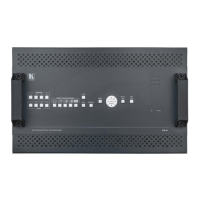Set MAC address.
To activate the
change, reset the device.
COMMAND
#FCT-MACmac_address<CR>
FEEDBACK
~nn@FCT-MACmac_address<CR><LF>
mac_address – Unique MAC address.
Format: XX-XX-XX-XX-XX-XX
where X is a hex digit
Set MAC address:
#FCT-MAC00-14-22-
01-23-45<CR>
COMMAND
#FCT-SNserial_num<CR>
FEEDBACK
~nn@FCT-SNserial_num<CR><LF>
serial_num – 14 decimal digits
Set serial number:
#FCT-SN1976384058
1123<CR>
Set HDCP mode.
Set HDCP working
mode on the device input:
HDCP supported -
HDCP_ON [default].
HDCP not supported -
HDCP OFF.
HDCP support changes
following detected sink -
MIRROR OUTPUT.
When you define 3 as the
mode, the HDCP status is
defined according to the
connected output in the
following priority: OUT 1,
OUT 2. If the connected
display on OUT 2
supports HDCP, but OUT
1 does not, then HDCP is
defined as not supported.
If OUT 1 is not connected,
then HDCP is defined by
OUT 2.
COMMAND
#HDCP-MODin_index,mode<CR>
FEEDBACK
~nn@HDCP-MODin_index,mode<CR><LF>
in_index – Number that indicates the
specific input:
1-N (N= the total number of inputs)
mode – HDCP mode:
0 – HDCP Off
1 – HDCP On
2 – Follow Input
3 – HDCP defined according to the
connected output
Set the input HDCP-
MODE of IN 1 to Off:
#HDCP-MOD1,0<CR>
Get HDCP mode.
Set HDCP working
mode on the device input:
HDCP supported -
HDCP_ON [default].
HDCP not supported -
HDCP OFF.
HDCP support changes
following detected sink -
MIRROR OUTPUT.
COMMAND
#HDCP-MOD?in_index<CR>
FEEDBACK
~nn@HDCP-MODin_index,mode<CR><LF>
in_index – Number that indicates the
specific input:
1-N (N= the total number of inputs)
mode – HDCP mode:
0 – HDCP Off
1 – HDCP On
2 – Follow Input
3 – HDCP defined according to the
connected output
Get the input
HDCP-MODE of IN 1
HDMI:
#HDCP-MOD?1<CR>
Get HDCP signal status.
io_mode =1 – get the
HDCP signal status of the
sink device connected to
the specified output.
io_mode =0 – get the
HDCP signal status of the
source device connected
to the specified input.
COMMAND
#HDCP-STAT?io_mode,in_index<CR>
FEEDBACK
~nn@HDCP-STATio_mode,in_index,status<CR><LF>
io_mode – Input/Output
0 – Input
1 – Output
io_index – Number that indicates the
specific number of inputs or outputs
(based on io_mode):
1-N (N=total number of inputs or
outputs)
status – Signal encryption status -
valid values On/Off
0 – HDCP Off
1 – HDCP On
Get the output HDCP-
STATUS of IN 1:
#HDCP-
STAT?0,1<CR>
Get command list or help
for specific command.
COMMAND
#HELP<CR>
#HELPcmd_name<CR>
FEEDBACK
1. Multi-line:
~nn@Devicecmd_name,cmd_name…<CR><LF>
To get help for command use: HELP (COMMAND_NAME)<CR><LF>
~nn@HELPcmd_name:<CR><LF>
description<CR><LF>
USAGE:usage<CR><LF>
cmd_name – Name of a specific
command
Get the command list:
#HELP<CR>
To get help for
AV-SW-TIMEOUT:
#HELPav-sw-timeou
t<CR>
Set visual indication from
device.
Using this command,
some devices can light a
sequence of buttons or
LEDs to allow
identification of a specific
device from similar
devices.
COMMAND
#IDV<CR>
FEEDBACK
~nn@IDVok<CR><LF>
Set the image size.
Sets the image
properties of the selected
scaler.
COMMAND
#IMAGE-PROPscaler_id<CR>
FEEDBACK
~nn@IMAGE-PROPscaler_id,video_mode…<CR><LF>
scaler_id – Scaler number –
1 – Scaler1
2 – Scaler2
video_mode – Status
0 – Video enabled
1 – Video disabled
2 – Blank picture
Set the image size:
#IMAGE-PROP1<CR>

